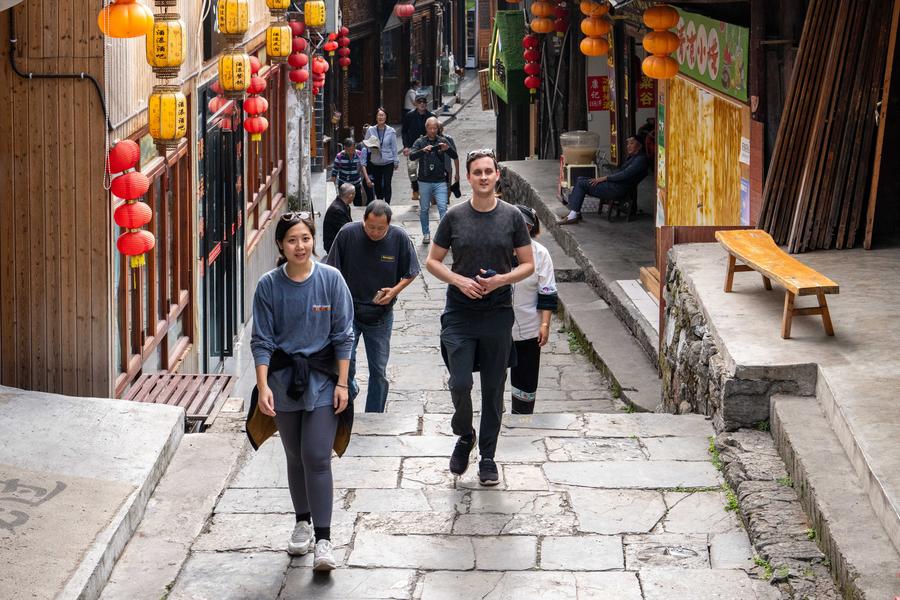Xinhua Headlines: Riding wave of "China Travel," international tourists explore country's hinterland
* Thanks to China's favorable measures for tourism, including a series of visa-free transit policies and payment facilitation services, as well as "China Travel," there is an inbound travel boom in once-poor mountainous regions.
* The Chinese mainland recorded an estimated 95 million inbound tourist arrivals in the first nine months, a 55.4 percent increase year on year, according to the Ministry of Culture and Tourism.
* According to the data center of the Ministry of Culture and Tourism, in the first three quarters of 2024, village tourism visits increased 15.5 percent yearly to about 2.25 billion, with total revenue up 9.8 percent year on year to 1.32 trillion yuan.
CHANGSHA, Nov. 21 (Xinhua) -- Jose Chaves, 40, from Costa Rica, recently visited Furong Town, enticed by pictures of its magnificent waterfall and traditional stilt houses built on the hillside -- famous features of this ancient scenic spot in Xiangxi Tujia and Miao Autonomous Prefecture, central China's Hunan Province.
"It's a very lovely and beautiful place. Entry, hotel reservation and transportation are convenient in China," said Chaves, who took a 12-day trip to China. "I will recommend this place to my friends and share my trip on social media."
With a history of more than 2,000 years and located in the hinterland of China's Wuling Mountains, the town of Furong in Xiangxi's Yongshun County is benefiting from the growing popularity of the "China Travel" campaign on global social media. Thanks to the campaign, it has seen a surge in inbound tourism.
 Foreign visitors take photos at the Furong Town scenic spot in Yongshun County, Xiangxi Tujia and Miao Autonomous Prefecture, central China's Hunan Province, Nov. 7, 2024. (Xinhua/Chen Sihan)
Foreign visitors take photos at the Furong Town scenic spot in Yongshun County, Xiangxi Tujia and Miao Autonomous Prefecture, central China's Hunan Province, Nov. 7, 2024. (Xinhua/Chen Sihan)
HINTERLAND TOURISM BOOM
"There were very few foreigners in the prefecture before poverty eradication. Now, it is not unusual to see foreign friends on the street," said Li Lichao, deputy head of the Culture, Tourism, Radio and Television Bureau of Xiangxi Tujia and Miao Autonomous Prefecture.
At Xiangxi's Shibadong Village, the idea of "targeted poverty alleviation" was first put forward in 2013. Through the strategy, 98.99 million people in rural China were lifted out of poverty, and all 832 impoverished counties were officially recognized as having escaped poverty by 2020.
The strategy advocates that development is the general method to eliminate poverty, and governments in poverty-hit regions should suit their measures to different conditions and help locals find ways to shake off poverty.
In the process of poverty alleviation and rural revitalization, the government of Xiangxi has explored the cultural and tourism industry to empower rural development.
Today, the prefecture has 161 enterprises in the cultural and tourism industry chain above the designated size, which refers to enterprises each with an annual main business turnover of at least 20 million yuan (about 2.8 million U.S. dollars). The tourism industry has contributed more than 70 percent of the GDP growth of Xiangxi in recent years, with more than 500,000 people working in the sector.
"Ancient townships, such as Furong, Fenghuang and Aizhai, which blend natural wonders and cultural interests, are particularly popular among foreign tourists," said Li.
Thanks to China's favorable measures for tourism, including a series of visa-free transit policies and payment facilitation services, as well as "China Travel," there is an inbound travel boom in this once-poor mountainous region.
In the first three quarters of this year, the prefecture received 254,000 inbound tourist visits, a year-on-year increase of nearly four times. The Chinese mainland recorded an estimated 95 million inbound tourist arrivals in the first nine months, a 55.4 percent increase year on year, according to the Ministry of Culture and Tourism.
 A drone photo taken on Nov. 7, 2024 shows a view of the Furong Town scenic spot in Yongshun County, Xiangxi Tujia and Miao Autonomous Prefecture, central China's Hunan Province. (Xinhua/Chen Sihan)
A drone photo taken on Nov. 7, 2024 shows a view of the Furong Town scenic spot in Yongshun County, Xiangxi Tujia and Miao Autonomous Prefecture, central China's Hunan Province. (Xinhua/Chen Sihan)
"My schedule has been fully booked for the past few months receiving foreign tourists," said Xu Yan, Chaves' English-speaking tour guide during his journey in Xiangxi, adding that most of her clients are from visa-free entry countries such as Thailand, Singapore and the Republic of Korea.
According to Sun Jiashan, an associate researcher from the Central Academy of Culture and Tourism Administration, more and more foreign tourists are gradually exploring China's rural and mountainous areas, rather than just visiting the metropolis.
Sun said that Xiangxi is attracting more overseas tourists thanks to the continuous improvement of facilities and infrastructure for rural tourism, and the improvement of services and overseas marketing.
"The phenomenon is the result of strategies of poverty alleviation and rural revitalization," he said.
BUSINESS OPPORTUNITIES, CULTURAL EXCHANGES
In order to better connect with the overseas tourism market, Xiangxi has strengthened cooperation with travel platforms, social media and overseas influencers since last year. Other efforts include increasing multilingual signs and facilitating payment services.
"We have been cooperating with online travel agency Trip.com, to promote Xiangxi to overseas tourists and facilitate their booking accommodation and tickets at our scenic spots," said Su Jun, a staffer responsible for the marketing and branding of Furong.
In March, over 100 overseas influencers were invited to Furong to experience and make promotions online. In order to serve foreign tourists, Furong has set up a team of English tour guides, and also a talent pool of over 100 guides speaking Russian, French, Japanese, Korean and other foreign languages, according to Su.
Deng Ni, 36, a native resident of Furong, quit her job in downtown Yongshun, returned to her hometown and started her homestay business in May last year. Foreign tourists have given her good comments on online traveling platforms, praising her fluent English communication skills and attentive service.
"In the past, visitors to Furong Town were mainly domestic tourists. However with the 'China Travel' boom, overseas tourists have "changed" the traditional off-season, like November and December, into a peak season," said Deng. She added that more than half of her bookings had been made by overseas tourists during the two-month period.
In Furong, another homestay owner called Qu Zhangxun started learning English to better serve foreign tourists. His homestay, featuring rooms with excellent views of the waterfall, has received guests from more than 20 countries and accepted overseas reservations for accommodation until October next year.
"I have asked my staff to be skilled in using translation apps, and I am also learning it myself. I hope to make all my tourists want to come back again and again," said Qu.
 People visit the Furong Town scenic spot in Yongshun County, Xiangxi Tujia and Miao Autonomous Prefecture, central China's Hunan Province, Nov. 7, 2024. (Xinhua/Chen Sihan)
People visit the Furong Town scenic spot in Yongshun County, Xiangxi Tujia and Miao Autonomous Prefecture, central China's Hunan Province, Nov. 7, 2024. (Xinhua/Chen Sihan)
According to the data center of the Ministry of Culture and Tourism, in the first three quarters of 2024, village tourism visits increased 15.5 percent yearly to about 2.25 billion, with total revenue up 9.8 percent year on year to 1.32 trillion yuan.
Last week, seven villages in China, including Shibadong Village in Xiangxi, were honored as "Best Tourism Villages" by the United Nations World Tourism Organization. They are highly representative in terms of geography, culture and development models.
For example, at Azheke Village, nestled in the heart of the Honghe Hani Rice Terraces in southwest China's Yunnan Province, a UNESCO World Heritage Site, villagers have contributed resources such as terraces, houses and traditional ways of life, creating a model of collective participation and shared prosperity.
Xiaogang, a village in Anhui Province where China's rural reform began over four decades ago, is another location making strides on its new journey toward achieving rural revitalization. Today, visitors from across the globe can witness the profound changes China has undergone by exploring this village.
During the third Xiangxi Tujia and Miao Autonomous Prefecture Conference on Tourism Development held earlier this month, Olga Vakhrousheva, honorary vice president of New Zealand-China Maori Culture Tourism Promotion Association Incorporated, came to Yongshun from New Zealand to sign cultural and tourism agreements, advocating cooperation activities such as developing more tourism projects and organizing more exchange visits.
"Furong Town is like a fairy tale. China has such a rich culture and variety of history, and showing them to the world would be great," she said.
Vakhrousheva shared her experiences of making tea, cooking, drinking and singing with local people in a village in Yongshun. She said she noticed similarities between residents in Xiangxi and Maori people, who also have traditions such as singing when guests are invited into villages.
"If we can do exchanges with kids, helping them to learn about other cultures, they can be open to each other and do things together when they grow up," said Vakhrousheva.
(Video reporter: Dai Bin, Zhang Yujie, Chen Sihan and Ju Yinhe; Video editors: Hong Ling, Zak Zuzanna, Zhang Yuhong, Zhu Cong and Zhang Nan)
- Norway's travel fair sees growing interest in China travel
- Chinese cities buzz with tourists from ROK amid expanded visa-free access
- Eyes on Hainan: Over 350,000 foreign tourists experience Hainan visa-free this year
- Infographics | China extends visa-free transit to 240 hours
- GLOBALink | "China Travel" booms in 2024 with visa-free transit policy


